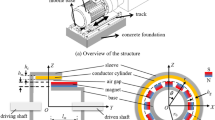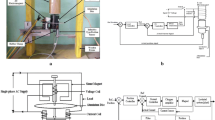Abstract
Watt balance system is the promising equipment to determine Planck constant without accurate measurement of magnetic flux and coil length. To obtain high measurement uncertainty, uniform magnetic flux density and constant velocity control are required during the coil movement. For that KRISS watt balance system incorporates a closed-type cylindrical permanent magnet, vertical linear motor and piston guide. In this paper, the vertical actuating motor including piston guide is controlled to have constant speed and magnet assembly was fabricated to have high uniform magnetic flux density during the vertical coil movement. The velocity of moving coil was controlled within 4 × 10-3 (1σ) at the velocity of 2 mm s-1 using a linear motor and linear encoder feedback. Using 3-vertical homodyne laser interferometer the velocity ripple of coil located inside magnet is measured within the level of 7.35 × 10-3 (1σ) at the same speed. A magnet assembly, which consists of two permanent magnet rings and closed yokes, was fabricated. A flux shunt was designed for the magnet for minimizing the temperature effect. The yokes were divided into three parts: top, center, and bottom yokes. By re-machining of center outer yoke, magnetic flux density uniformity was improved. The uniformity of the magnetic field was within 3.9 × 10-4 over a vertical distance of 20 mm.
Similar content being viewed by others
References
Haddad, D., Seifert, F., Chao, L. S., Li, S., Newel, D. B., et al., “Invited Article: A Precise Instrument to Determine the Planck Constant, and the Future Kilogram,” Review of Scientific Instruments, Vol. 87, No. 6, Paper No. 061301, 2016.
Sanchez, C., Wood, B., Green, R., Liard, J., and Inglis, D., “A Determination of Planck's Constant Using the NRC Watt Balance,” Metrologia, Vol. 51, No. 2, pp. S5–S14, 2014.
Baumann, H., Eichenberger, A., Cosandier, F., Jeckelmann, B., Clavel, R., et al., “Design of the New Metas Watt Balance Experiment Mark II,” Metrologia, Vol. 50, No. 3, pp. 235–242, 2013.
Sutton, C. M., Fitzgerald, M. P., and Jack, D. G., “The Concept of a Pressure Balance Based Watt Balance,” Proc. of IEEE Conference on Precision Electromagnetic Measurements (CPEM), pp. 131–132 2010.
Kim, D., Woo, B.-C., Lee, K.-C., Choi, K.-B., Kim, J.-A., et al., “Design of the KRISS Watt Balance,” Metrologia, Vol. 51, No. 2, pp. S96–S100, 2014.
Seifert, F., Panna, A., Li, S., Han, B., Chao, L., et al., “Construction, Measurement, Shimming, and Performance of the NIST-4 Magnet System,” IEEE Transactions on Instrumentation and Measurement, Vol. 63, No. 12, pp. 3027–3038, 2014.
Bielsa, F., Lu, Y., Lavergne, T., Kiss, A., Fang, H., and Stock, M., “Alignment of the Magnetic Circuit of the BIPM Watt Balance,” Metrologia, Vol. 52, No. 6, pp. 775–782, 2015.
Gournay, P., Genevè s, G., Alves, F., Besbes, M., Villar, F., and David, J., “Magnetic Circuit Design for the BNM Watt Balance Experiment,” IEEE Transactions on instrumentation and Measurement, Vol. 54, No. 2, pp. 742–745, 2005.
Tommasini, D., Baumann, H., Eichenberger, A., and Vorotszhov, A., “The Ultra-Stable Magnet of the MarK II Experiment,” IEEE Transactions on Applied Superconductivity, Vol. 26, No. 4, pp. 1–5, 2016.
Kim, D., Woo, B.-C., Ha, D., Lee, S.-U., Park, H.-S., et al., “Piston Guide and Magnet Assembly for the KRISS Watt Balance,” Proc. of IEEE Conference on Precision Electromagnetic Measurements (CPEM), pp. 1–2 2016.
ACS Motion Control, “Modern Motion Control Strategies Obtain Consistent and Better Performance in Uncertain Conditions,” https://www.acsmotioncontrol.com/sites/ACS/UserContent/files/downloads/level1/White%20Papers/Modern%20Motion%20Control%20Strategies%20Obtain%20Consistent%20Better%20Performance%20in%20 Uncertain%20Conditions%202010-02.pdf (Accessed 8 JUN 2017)
Author information
Authors and Affiliations
Corresponding author
Rights and permissions
About this article
Cite this article
Kim, M., Kim, D., Woo, BC. et al. Establishment of KRISS watt balance system to have high uniformity performance. Int. J. Precis. Eng. Manuf. 18, 945–953 (2017). https://doi.org/10.1007/s12541-017-0112-6
Received:
Revised:
Accepted:
Published:
Issue Date:
DOI: https://doi.org/10.1007/s12541-017-0112-6




